Begin Again Again by Tod Machover Is Scored Quizlet
Chapter Six: The History of Electronic and Calculator Music
1902
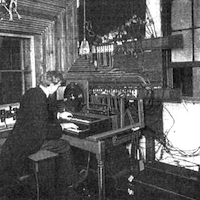
Thaddeus Cahill sets upwardly the Telharmonium or Dynamaphone, a 200-ton array of Edison dynamos that produced different pitched hums according to the speed of the dynamos. The electrical output was "broadcast" over telephone lines to subscribing hotels and audiences in Telharmonic Hall. While the instrument was not ultimately a commercial success, it did inspire the thinking of Ferruccio Busoni, who himself would continue to influence the thinking of Varèse and others.
1906
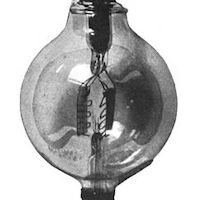
Lee DeForest invents and patents the Triode Vacuum Tube (called appropriately the Audion) which led to distension of electrical signals by 1912 and tube oscillator circuits several years later that, opening the door for an explosion of electronic instruments in the 1920's.
1907
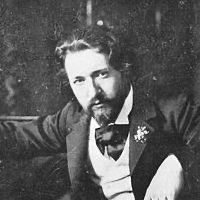
Ferruccio Busoni publishesSketch for a New Artful of Music (Entwurf einer neue Ästhetike der Tonkunst ) discussing the utilise of electrical and other new sound sources in future music. He was to accept a profound effect on his educatee, Edgard Varèse, who met him in 1907. Varèse wrote toward the end of his life that reading Busoni'due south writings was "milestone in my musical development, and when I came upon 'Music is born costless, and to win freedom is its destiny,' it was like hearing the echo of my thought." While Busoni heralded the use of electronics and microtonality, he never made use of either in his compositions.
19teens
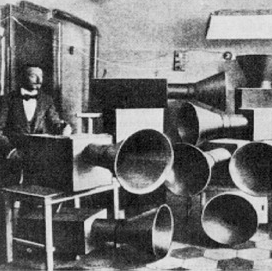
Italian futurists investigate, allocate, and produce noise instruments called intonarumori (pictured left with Russolo). About notable was Luigi Russolo, who wrote a letter/treatise entitled 50'arte dei Rumori or The Art of Noises, in which he embraced modernity'due south new world of sounds which the modern world had brought forth. They embraced the infinite variety of noise, old and new, including those created electronically and other mechanisms for use by futurity composers that broke out of the traditional orchestral palette. They classified these new sounds into 6 main noise categories (including the ever-popular "decease rattles"). Marinetti met with Busoni in 1912, and Russolo and Marinetti give the commencement concert of Futurist music in 1914 in Milan using their intonarumori. Near of the instruments were destroyed in WWII bombing or lost, as no originals currently exist. The Futurists were one of the few artistic movements in history that gravitated towards Fascism.
DeForest and Edwin Armstrong separately develop audio tube oscillators in 1917.
1920's
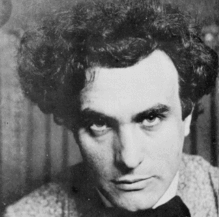
Varèse (pictured left) writes Ionisation and George Antheil composes Ballet Mecanique: both use percussion and racket instruments in a unique, featured way (i.east. they are the stars, and not just supporting cast) and bargain with the "liberation of sound" and a new view of musical "spatial-temporal" relationships. Varèse later said of his ideas, "I dream of instruments obedient to thought—and which, supported past a flowering of undreamed-of timbres, will lend themselves to any combination I choose to impose and will submit to the exigencies of my inner rhythm." A collection of his lectures on the liberation of sound can be downloaded here. Antheil'southward Ballet Mècanique was the score for a Dadaist/mail service-Cubist movie of Fernand Léger (click link to run into on YouTube, but worth searching for if link has moved).
Electronic instruments invented during this menses include the Theremin (1919-20), Ondes-Martenot (1928), Trautonium (1928), and Hammond Organ (1929) based on technical principles of the Telharmonium. Run into 120years.net for an unbelievably complete description of these and many other early electronic instruments. In 1924, Full general Electrical released moving-roll loudspeakers, a technology nonetheless in use today. Harry Nyquist develops digital sampling theory. Optical flick soundtrack composing begins.
Messiaen wroteFete des belles eaux (1937) for half-dozen ondes-martenot as well equally featuring the instrument as soloist inTrois petites liturgies de la Presence Divine (1944) and Turangalila-symphonie (1946-8). Strauss, Hindemith and Varèse (two used originally in hisEcuatorial) equanimous for the Trautonium.
1930's
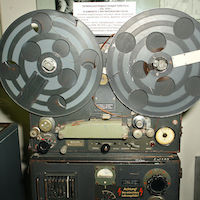
Improvement of amplifiers and invention of the record recorder . Neo-Dadaist-inspired John Muzzle composes Imaginary Landscape no. 1 (1939) and no. 2 (1942) using test-tones from recordings, which were played on variable-speed turntables. Léon Theremin designs the Rhythmicon for composer Henry Cowell, which could generate xv complex and syncopatable rhythms based on a transposable fundamental frequency. He wrote Concerto for Rhythmicon and Orchestra with information technology, and several other works, though it before long barbarous into disuse.
1940's
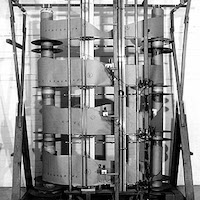
Egyptian-born composer Halim El-Dabh experiments with wire recorders in Cairo. In 1944, he produces The Expression of Zaar, using field sound recordings of a street festival and manipulating it using equipment such as reverb chambers at the Eye East Radio station. It is considered past many to be the first slice of musique concrète performed in concert. The slice was later abridged and released as Wire Recorder Piece. El-Dabh came the the U.s., worked at the Columbia-Princeton studios and is perhaps all-time known for his expansive Leiyla Visitations.
Free Music Car (pictured left) invented, which generated sound via 8 oscillators controlled in parameters of pitch, volume, completely free rhythm and timbre by freely sketching on a optically-read main roll of an 80"-wide graph paper, along with several auxiliary rolls. Information technology was adult by composer Percy Grainger (who was likewise a educatee of Busoni) and Burnett Cross. It was mayhap a forerunner to the graphic-sound-control UPIC arrangement Xenakis developed decades later.
1948
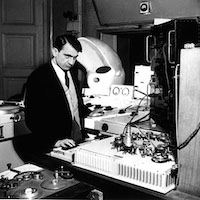
RTF (Radiodiffusion-Télévision Française, became ORTF (Office de RTF) in 1964, and later becoming GRM) broadcasts Pierre Schaeffer'due southEtude aux chemins de fer on Oct. 5th. This marks the beginning of studio realizations and for some (see El-Dabh above), musique concrète . Musique concrète is characterized equally compositions whose materials originate as real-world, recorded sounds which are reorganized, sometimes processed via tape splicing, speed or direction change, looping, filtering, and so along. Schaeffer conceptualized the original sounds as L'Objet Sonore, or the sonic object, a unit of limerick plucked from its original context. The extremely deep aesthetic is explained by Schaeffer (pictured left) in his Treatise on Musical Objects, recently translated into English language. Pierre Henry collaborates with Schaeffer onSymphonie pour un homme seul (1950), the start major work of musique concrète. In 1951, the studio was formally established as the Groupe de Recherche de Musique Concrète, which included other composers such as Messiaen, Boulez and Stockhausen.
1950
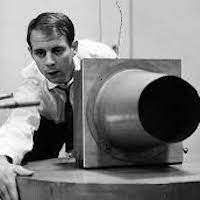
Studio established in Cologne (Köln), Germany past Herbert Eimert, Robert Beyer and Werner Meyer-Eppler (physicist) at German radio NWDR (Nordwestdeutscher Rundfunk, which later became WDR) . Karlheinz Stockhausen (pictured left) nearly influential. While the French RTF was primarily concerned with manipulation of acoustic sound sources (musique concrète), the NWDR studios were equipped with electronic audio generators and modifiers, and the creative product was referred to as electronische Musik, where the origins of the sounds were artificially created via oscillators, noise generators, etc..
Toru Takemitsu and other Japanese artists founded the artist'due south commonage Jikken Kobo in 1951, which soon afterwards collaborated with TTK (presently to exist Sony Corporation) and used their new tape recorders to produce musique concrète, multimedia works and concerts of both Western avant garde and Japanese pieces.
1952
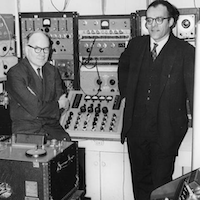
4 compositions for tape recorder, composed by Vladimir Ussachevsky and Otto Luening (pictured left), presented at the Museum of Modern Art, New York (on Oct 28) with works equanimous at the Columbia Tape Music Center, which they established the previous year, the forerunner of the Columbia-Princeton Electronic Music Centre. Raymond Scott (extremely financially successful radio/tv/experimental composer and inventor) designs arguably the first electro-mechanical sequencer in 1953 which consisted of hundreds of switches decision-making stepping relays, timing solenoids, tone circuits and sixteen individual oscillators. Scott also invents Clavivox synthesizer with subassembly past Robert Moog (1956) with his Manhattan Research Company.
1953
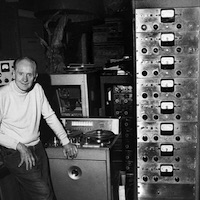
Edgard Varèse receives Ampex tape recorder as gift and begins work on Déserts, for wind and percussion orchestra with tape interludes. Stockhausen completes Studie I, fashioned from pure sine tones organized in merely intonation ratios (except for the "one-gun salute" to his girl's showtime birthday). Famous guitarist, guitar designer and strong proponent of improved recording technology Les Paul commissions Ampex to build an eight-track tape recorder (pictured with Les Paul left), as he had been previously recording multiple tracks on private synchronized acetate disks. He had pioneered the tape flanging effect the year before.
1955

Milan Studio de Fonologia RAI established, with Luciano Berio equally artistic director. Toshiro Mayuzumi founds the NHK studio in Tokyo, modeled subsequently the German NWDR facilities, where he composed three études in 1955 modeled subsequently Stockhausen'southward. Phillips studio established at Eindhoven, Kingdom of the netherlands, but was shifted to University of Utrecht Found of Sonology in 1960. Canadian composer Hugh Le Caine composesDripsody, an oft-cited quintessential case of musique concrète, using a recording of a single drip of water into a waste basket every bit the just sound source. He created loops of the baste transposed past a keyboard connected to a varispeed tape recorder. Sadly Le Caine died in a motorbike accident in 1977 at the age of 63.
1956-7

Lejaren Hiller and Leonard Isaacson compose the Illiac Suite for string quartet, the first complete piece of work of figurer-assisted composition or CAC (also called algorithmic composition), created using the ILLIAC I computer at the University of Illinois. Stockhausen composes Gesang der Jünglinge ("Song of the Youths"), the showtime major work of the WDR Cologne studio, based on text from the Book of Daniel. The 13-minute work combined an interplay of both concrète (boy's vocalisation) and electronic ways past matching timbres and phonemes, with statistical density principles of system Stockhausen learned from courses with Werner Meyer-Eppler. Gesang originally sported 5-channel spatialization.
Max Mathews, working for Bell Labs, creates offset circuitry to catechumen digital data into analog sound, resulting in the Music I synthesis language. It had 1 voice, no envelope, but pitch, elapsing and aamplitude could be specified. It would atomic number 82 to a 60-year cord of developments of direct digital synthesis languages and programs, beginning with what are today referred to equally the Music-N family of languages.
1958
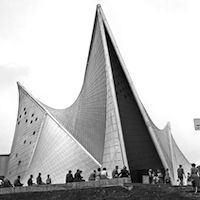
Poème électronique played on over 400 loudspeakers at the Phillips Pavilion (pictured left, designed by famed architect Le Corbusier, whose assistant was Iannis Xenakis!) of the 1958 Brussels World Off-white. Additionally, Concret PH, by Xenakis, was also played inside the pavilion. Attendees processed through the pavilion to view a pic, slides and lighting on the walls and ceiling. The evolving audio-path was diffused upward and down the textured, asbestos-coated interior, from three original mono tapes that were pre-panned onto 3 stereo tapes, with all being spatially controlled by both by a perforated command tape and sound projectionists using phone-dial-mode rotary controllers. A virtual Poème reconstruction can be viewed here.
1959

Columbia-Princeton Electronic Music Center was established in New York with the assistance of a $175,000 Rockefeller grant. It incorporated the room-sized RCA Marking Two synthesizer (pictured left with Milton Babbitt), built in 1957 and designed by RCA engineers Harry Olson and Herbert Belar as a successor to their more limited RCA Marker I, with envelope generators developed by Robert Moog. The tube-based circuitry was controlled past a punch-tape rolls, visible in the picture, that automatic many of the sound parameters and was more than complimentary to the ultra-serial techniques of many of its users than tape splicing. The output was originally cut to a synchronized tape lathe. It is often considered the kickoff major voltage-controlled synthesizer. Composers using Victor every bit it was affectionately known, included Babbitt, Davidovsky, Luening, Ussachevsky, Wuorinen, Smiley, Druckman, Shields, Spiegel, Carlos and many more. Milton Babbitt produced Philomel (1964) and several other compositions on the motorcar.
1960'southward

Evolution of practical big mainframe reckoner synthesis. Max Mathews of Bell Labs (pictured left with his afterward Radio Drum interface) perfects MUSIC 5, a directly digital synthesis linguistic communication, by 1968. The father of computer music, every bit he is known, practical sampling theory to computer algorithms beginning in 1957 with Music I (mentioned higher up), much of which was written in assembly linguistic communication for specific models of computers (to speed up the lengthy calculations). The plan generated digital sample output from "orchestra" and "score" files, originally input with dial cards. The program'due south digital output was written to magnetic data tape that and then had to exist played through a DAC converter to produce audio. Many generations of ports and iterations are yet being used today, for example, with Csound and Cmix, and the principles Mathews developed are in use by virtually all digital audio applications. In curt, he was a giant of a human, actively inventing and attending festivals until his death in 2011 at the historic period of 84.
Evolution of smaller voltage-controlled synthesizers by Moog and others make instruments available to most composers, universities and popular musicians. Most well-known use of the Moog modular was Switched-on Bachanthology by then Walter, now Wendy Carlos. Beginning of alive electronic performance. Paul Ketoff developed the Synket, a live operation instrument used extensively by composer John Eaton in works such asConcert Piece for Synket and Orchestra(1967). London-based Ems released a VCS3 (known as the Putney) and later the legendary Synthi 100. Once Festivals, featuring multimedia theater music, were organized by Robert Ashley and Gordon Mumma in Ann Arbor, Michigan.
1962
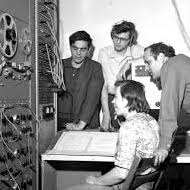
San Francisco Tape Music Eye (pictured left) established by Morton Subotnik and Ramon Sender, and presently joined past Pauline Oliveros (who served as director), incorporating a voltage-controlled synthesizer congenital by Donald Buchla based around automated sequencing, used in album-length Subotnik pieces such asSilver Apples of the Moon(1967) andThe Wild Bull(1968).
James Tenney, composer and theoretician, completes the computer-synthesized Four Stochastic Studies at Bell Labs, equanimous the year afterward creating the now-classic Collage No.ane (Blue Suede), shredding Elvis'southward rendition the year earlier as a grad student at the University of Illinois. Tenney left Bell Labs in 1964 after developing his PLF composing program there.
Likewise in 1962 Hubert Howe, Godfrey Winham and J. Chiliad. Randall, at Princeton University, not far from Bong Labs, improved upon Max Mathew'south and Joan Miller'southward Music IV user interface and called information technology Music IV-B (later Music Four-BF when Howe rewrote in the non-assembler Fortran linguistic communication). It ran on Princeton's mainframe, the same model IBM 7094 Bell Labs had, i of the offset transistorized mainframes. When IBM changed over to the IBM 360 mainframe toward the stop of the decade, Barry Vercoe, who was moving from Yale to MIT, updated the program to run on the 360 assembler language and appropriately called it Music 360.
1964-1968

Stockholm Elektronmusikstudion (European monetary system) is founded in 1964 along with Montreal's McGill University Electronic Music Studio (another Ems). Stockhausen composesMikrophonie I for amplified and signal-candy tam-tam). In 1965, Robert Moog'due south R. A. Moog Co. releases its outset commercial voltage-controlled modular analog synthesizer (pictured left), with pattern help from Herbert Deutsch. Unlike the tube-based RCA Mark Two, Moog incorporated transistors into the circuitry.
John Chowning of Stanford CCRMA studios develops digital FM synthesis (anecdotally past accident while experimenting with farthermost rates of vibrato), eventually leading to the commercial release of the FM-based Yamaha DX-7 synthesizer (come across below). The royalties from the audio FM patent funds the Stanford CCRMA studios for many years to follow. Max Mathews and F. Richard Moore develop GROOVE, a real-time digital control system for analog synthesis, used extensively by composers Laurie Spiegel and Emmanuel Ghent in the 1970's. In 1966, Chowning, along with David Poole, write Music 10, a variant of Music Iv designed to run on Stanford's PDP-10 computer.
In 1968, Mathews, Milller, Moore and Jean-Claude Risset complete Music V, possibly the most famous direct digital synthesis program ever written (it was distributed to studios with 2 large boxes of punch cards!). The following year, Risset, however researching at Bell Labs composes Mutations using it.
1970's
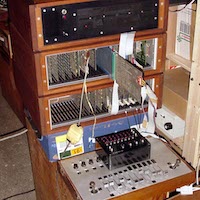
Mini-Moog, a small affordable integrated synthesizer, makes analog synthesis easily available and affordable, along with newcomers ARP and Oberheim. Charles Contrivance composesVoice communication Songs (1972) based on early Bong Labs spoken language synthesis research. Jon Appleton (with Jones and Alonso) invents the Dartmouth Digital Synthesizer, later to become the New England Digital Corp.'s Synclavier (1st version pictured left), making real-time digital synthesis a reality (you play a fundamental, yous hear a note). The Synclavier would go on to be non simply a existent-fourth dimension performance keyboard, merely also a major studio hard disc recording platform for those that could afford the pricey setup. The Fairlight CMI (Reckoner Music Instrument) was a cheaper existent-time digital synthesizer and sampler with a digital sequencer and was released in 1979.
Princeton opens a computer music lab (primarily to catechumen digital tape to analog) in 1970 with Godfrey Winham and Kenneth Stieglitz then composers would not take to bulldoze their digital tapes upwardly to Bong Labs in MUrray Hill, NJ to be converted. It would eventually exist renamed the Godfrey Winham Lab later on Winham'due south early decease. In 1975, with Chowning's guidance, Stanford opens the Center for Figurer Research in Music and Acoustics or CCRMA. Many luminaries in the field would come to work at that place, including Max Mathews, Chris Chafe, Ge Wang, Julius O. Smith and John Pierce.
In 1973, Barry Vercoe, who found the MIT Experimental Music Studio (yet some other Ems) ii years earlier, writes Music 11, a adjacent-generation music synthesis programme, named in office for the PDP-eleven minicomputer it was designed for. Music 11 was notable for providing separate sampling rates for audio signals and control signals (which did non require as much resoluation every bit sound, and hence fabricated the process more efficient), a distinction maintained in almost all subsequent digital music applications (for example, in current-solar day MAX, objects with tildes(~) are computed at audio charge per unit, those without are computed at a lower control rate).
IRCAM, the Institut de Recherche et Coordination Acoustique/Musique (Paris) becomes a major eye for computer music research and realization and develops 4X computer organisation, featuring then revolutionary real-time digital indicate processing. With Pierre Boulez every bit managing director, and Berio named as creative manager, many notables in the field researched and worked there, including John Chowning, Stanley Haynes, Miller Puckette, Jean-Claude Risset, Tristan Murail, Jonathan Harvey and many more. Murial, a leading proponent of the spectralist arroyo to composition writes Désintégrations for big ensemble and electronic playback in 1982 based on spectral modeling of existent instruments. Murail, who taught composition at IRCAM for seven years before moving to Columbia University, follows that a decade later with his second IRCAM commission, resulting in Fifty'Esprit des dunes, another work for ensemble and electronics, but this fourth dimension, with the electronics coordinating with the ensemble via an interactive MAX patch controlled by a keyboard.
In 1976, Iannis Xenakis established the Centre d'Etudes de Mathématique et Automatique Musicales or CEMAMu . It is perhaps all-time known for the evolution of the UPIC (Unité Polyagogique Informatique CEMAMu) composition system which takes realtime input from a graphics tablet to command digital musical parameters. UPIC was used past Xenakis to produce Mycènes Blastoff in 1978 and several other works. Xenakis established a mirror facility at Indiana University, the Center for Mathematical and Automatic Music (CMAM), at present CECM, from 1966-1972 after which he left IU.
In 1977, MIT Printing begins publishing the Estimator Music Journal, complete with sound discs to accompany the peer-reviewed articles on the latest research and creative activity in the field.
Paul Lanky, of Princeton University, composes 6 Fantasies on a Poem by Thomas Campion in 1978-9 using an IBM 360 mainframe computer and a math process he applied to music cantankerous-synthesis called Linear Predictive Coding or LPC. For the work, he takes the spoken voice of his spouse and transforms the aspects of speech into harmonized textures based on the contours, vowels, articulations, etc. of the text. Lansky went on to write several digital signal processing software packages including Cmix, MIX and RT, which are carried on today in the open up-source RTcmix software packet developed in the mid-1990's past Brad Garton, David Topper and afterward several others such equally CECM director John Gibson and erstwhile CECM pupil, Doug Scott.
Besides in 1979, the International Reckoner Music Association (ICMA) is founded and is still i of the main worldwide organizations for the field, holding annual conferences called International Calculator Music Briefing(due south) or ICMC.
1980's
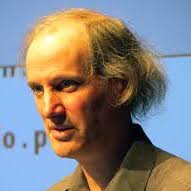
Pierre Boulez'southRepons(1981) for 24 musicians and 6 soloists uses the IRCAM 4X (to a higher place) to transform and route soloists to loudspeaker organisation. MIDI instruments and software make powerful control of sophisticated instruments easily affordable past many studios and individuals. Acoustic sounds are reintegrated into studios via sampling and sampled-ROM-based instruments. Miller Puckette (pictured left) develops graphic signal-processing software for 4X chosen MAX (after Max Mathews), later ports it to Macintosh (with Dave Zicarelli extending information technology for Opcode) for real-time MIDI command, bringing algorithmic composition availability to most composers with pocket-sized figurer programming background. Yamaha introduces DX-7 MIDI keyboard, based on FM synthesis algorithms developed by John Chowning at Stanford University.
MIDI Specification 1.0 published in 1985 past the MIDI Manufacturers Association. Likewise in 1985, Digidesign releases Sound Designer software for the Macintosh, the first consumer-level hard-disk recording and editing software. David Jaffe, Julius Smith and Perry Cook (CCRMA studios of Stanford University) prototype physical modeling, a method of synthesis in which physical properties of existing instruments and represented equally figurer algorithms which can so be manipulated and extended. Barry Truax composes Riverrun in 1986, using new granular synthesis techniques controlled in realtime using a PDP mini-computer controlling a DMX-1000 DSP. Kyma, a graphics-based sound-synthesis and DSP environment created by Carla Scaletti in 1986, is released for the proprietary Platypus DSP, and notwithstanding going stiff in 2020 with new DSP boxes traditionally named later large South American rodents.
In 1982, Jonty Harrison established the BEAST, the Birmingham ElectroAcoustic Audio Theatre at the University of Birmingham, England, which focused on acousmatic music peculiarly designed for live agile loudspeaker improvidence. The facility houses a concert hall with a big number of speakers, perchance up to 100, of various sizes, heights, and fifty-fifty directions, with some facing away from the audience. Acousmatic music continues to gain in popularity, peculiarly in Europe and Canada.
In 1984, Barry Schraeder, along with Jon Appleton and several others form the Society for Electro-acoustic Music in the US or SEAMUS, which is still one of the several premiere organizations in the field, and holding national annual conferences as well as disseminating a serial of recordings, now almost 30 CD's, called Music from SEAMUS. In 1989, the Center for New Music and Audio Technologies (CNMAT) is founded at UC Berkeley. In the late 1990'south at CNMAT, Adrian Freed and Matt Wright would develop the Open Sound Control (OSC) network protocol to transport music-parameter information beyond networks and between devices.
IN 1985, MIT opened its Media Lab with Barry Vercoe as a founding member and leader of the Music, Listen, and Machine group . Tod Machover too joined the Media Lab faculty that same year after serving every bit IRCAM's Director of Musical Enquiry since 1980. Princeton was collaborating more and more with Bell Labs, and by the mid-1980'southward had developed its ain facilities with English language-born Godfrey Winham and Paul Lansky. Also, in 1985, Barry Vercoe updated his Music 11 programme to Csound , which is still widely used today, and connected the lineage of the Music-N family of languages (though minus the '-Due north' nomenclature).
As well, in 1989, the Steve Jobs-designed Next calculator was released with the Music Kit (changed after to Audio Kit) software congenital into the OS. Written past David A. Jaffe and Julius O. Smith, it supported the onboard Motorola 56001 DSP chip. Effectually the same time, IRCAM too incorporated their live-processing software expertise into the IRCAM Betoken Processing Workstation (ISPW), up to three large 2-processor expansion boards for the Adjacent reckoner running their Faster Then Audio (FTS) server and a version of MAX, also with multichannel recording and playback. At effectually $12K at the time (well-nigh $25K now), information technology was not toll-effective for nigh smaller studios. The FTS/MAX software was afterwards ported, without the need for the DSP boards to SGI and other platforms.
1990'south

Interactive calculator-assisted operation becomes popular. Tod Machover's (MIT, IRCAM)Begin Once again Again for "hypercello," an interactive organisation of sensors measuring physical movements of cellist premiered by Yo-Yo Ma. Max Mathews perfects Radio Baton to compliment his Conductor program for existent-time tempo,dynamic and timbre control of a pre-input electronic score. Morton Subotnik releases multimedia CD-ROMAll My Hummingbirds Have Alibis (pictured left). MIDI sequencing programs aggrandize to included digital audio. Big number of works for instrumentalist (or ensemble) and tape composed, such as James Mobberley'southwardCircumspection to the Winds for pianoforte and tape, pioneered by Mario Davidovsky'sSynchronisms series several decades before.
Opcode releases a consumer version of MAX software in 1990, characterized by connecting graphic objects (like to the IRCAM software objects) on the screen via mouse-routed patch cords. Opcode's MAX was written by Dave Zicarelli, and at first manipulated MIDI data only. Zicarreli reacquired the rights and released it through its current visitor, Cycling'74 in 1997, around the same time Miller Puckette released Pure Data (Pd), a similar interface, and both could manipulate audio data as well, MAX being renamed MAX/MSP (for MAX Bespeak Processing). Both are yet going strong as of this writing in 2019, with MAX having added a visual creation chemical element originally chosen Jitter (now the whole parcel (data, audio, visuals) is just called MAX).
In the mid-xc's, James McCartney creates the SuperCollider realtime synthesis programming language, a descendant of the Music-N-style languages (such as Music V) which is open source and complimentary to download. SuperCollider is extremely powerful, does require some study and programming skills, and is oftentimes used for live coding, where composer/performers are typing to guide a composition as it is in procedure.
2000'due south
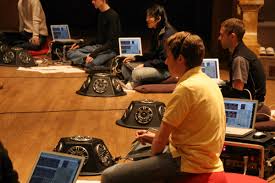
A new interest in expressive non-traditional real-time controllers adult, exemplified past the establishment of NIME (New Interfaces in Musical Expression), which held its outset conference in Seattle in 2001. The interest was enhanced past the release of the cheap Italian-designed Arduino ATmega microprocessor board in 2005. Subsequent models are all the same going strong for both live operation and installations. The Arduino allowed for physical, optical and environmental controller input to be digitized and used past applications, including the new Processing language, MAX, SuperCollider and Kyma. This in plow led to a new branch in the field called data-driven musical instrument design and composition, practiced today by composers such every bit Jeff Stolet and Chi Wang. Enhancing this trend, in 2004, the Lemur multi-impact control surface was adult and in 2008, TouchOSC was released for iPhone, calculation graphic, wireless touch command of CNMAT's Open Sound Control to manipulate a wide multifariousness of software.
Around 2003-2005, laptop orchestras, such as PLOrk (Princeton Laptop Orchestra), adult past Perry Cook and Dan Truman, and the SLOrk (Standford Laptop Orchestra), adult by Ge Wang, were established as a modern version of earlier electronic ensembles, such as Theremin and Ondes-Martenot ensembles of the prior century. Ii year prior, ChucK, an sound programming language written by Perry Cook and Ge Wang geared towards LORC'due south and alive coding, was released. Too, in 2003, the Sonic Arts Research Centre (SARC) is established in Belfast. One of it master focuses was 3D sound spatialization, diffused in its Sonic Lab, with Gary Kendall every bit master researcher.
2010's
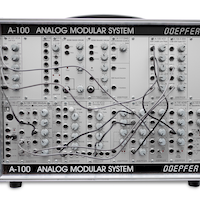
Even in electronic music, everything that goes effectually eventually comes effectually. Following renewed interest by rock project studios returning to reel-to-reel tape in the 1990's, and a return to music released on vinyl, the field of electronic music synthesis has returned to modular synthesis, consummate with patch cords with the Eurorack format modular instruments. Though Dieter Dopfer codified the concrete format in Frg in 1996 (pictured, his A-100 synth left), information technology has certainly gained popularity in the last decade, with thousands of individual modules for sale by hundreds of designers, and users pick and choose to build their own instruments. Some of these modules are purely analog, but many are hybrid analog/digital, and are driven past both MIDI keyboards and computers.
In 2013, Virginia Tech ICAT studios opens their Cube, a high-density loudspeaker array (HDLA) under the direction of Eric Lyon, Charles Nichols and Ico Bukvic. This built upon theatre-based immersive audio work done by Stephen Beck several years earlier at Louisiana Land University. The Cube speaker dome or acousmonium contained 150 speakers with computer-controlled routing to create complex 3D audio environments and audio directions. It also supported 3D wavefield synthesis, loftier-order ambisonics and video projection.
2020'southward

WE'RE Here! WE MADE It!
Recommended Historical Reading
Chadabe, Joel: Electrical Sound
Dean, Roger, Ed.: The Oxford Handbook of Estimator Music
Russcol, Herbert: The Liberation of Audio
Appleton, Jon and Perera, Ronald, Ed.: The Development and Practice of Electronic Music
Holmes, Thom: Electronic and Experimental Music: Technology, Music, and Culture
Source: https://cmtext.indiana.edu/history/chapter6_timeline.php